Temporal Characteristics Based Outlier Detection and Prediction Methods for PPP-B2b Orbit and Clock Corrections
Abstract
:1. Introduction
2. Temporal Characteristics of Orbit and Clock Corrections for PPP-B2b
2.1. PPP-B2b Signal Collection
2.2. Completeness and Continuity of the PPP-B2b Orbit and Clock
2.3. Jumps in Orbit and Clock Corrections
3. Outlier Detection and Predicted Algorithm of PPP-B2b Orbit and Clock Corrections
3.1. Calculation of PPP-B2b Orbit and Clock Products
3.2. PPP-B2b Orbit and Clock Correction Data Outlier Detection
3.2.1. Epoch Difference Outlier Detection
3.2.2. Median Absolute Deviation Outlier Detection
3.3. PPP-B2b Orbit and Clock Correction Prediction Model
4. Experiments and Results
4.1. Threshold for Outlier Detection
4.2. Positioning Experiments
4.2.1. Dataset and PPP Strategy
4.2.2. Simulated Dynamic Experiments
4.2.3. Real-time Dynamic Experiments
5. Discussion
6. Conclusions
- (1)
- Despite being in open environments and static scenarios, PPP-B2b service interruptions persist due to factors like signal transmission and IOD matching errors. Both BDS-3 and GPS correction sequences display instances of individual satellite jumps, with GPS occasionally experiencing simultaneous jumps among all satellites.
- (2)
- BDS-3 satellite orbit correction variations are relatively stable, with over 60% of time differences within 0.1 mm and about 80% within 1 mm. Conversely, GPS satellite orbit correction rates are notably higher than those of BDS-3, with approximately 80% of time differences exceeding 1 mm and about 40% exceeding 10 mm.
- (3)
- Differences among BDS-3 satellite clock corrections are minimal, with roughly 30% of time differences within 1 mm and about 70% within 1–10 mm. Beyond the validity period, reliability declines rapidly, with few instances exceeding 10 mm, primarily due to IOD changes and anomalies. GPS clock correction epoch differences are notably larger than those of BDS-3, displaying a more dispersed distribution.
- (4)
- The prediction models established in this study significantly enhance positioning continuity and stability during signal interruptions. In simulated dynamic experiments with a 30-min interruption duration, horizontal positioning accuracy remains within 7.4 cm. In real-time dynamic experiments, while extended correction values exhibit notable deviations, positioning results using predicted corrections closely align with normal corrections in the horizontal direction.
Author Contributions
Funding
Data Availability Statement
Acknowledgments
Conflicts of Interest
References
- Zumberge, J.F.; Heflin, M.B.; Jefferson, D.C.; Watkins, M.M.; Webb, F.H. Precise Point Positioning for the Efficient and Robust Analysis of GPS Data from Large Networks. J. Geophys. Res. Solid Earth 1997, 102, 5005–5017. [Google Scholar] [CrossRef]
- An, X.; Bellés, A.; Rizzi, F.G.; Hösch, L.; Lass, C.; Medina, D. Array PPP-RTK: A High Precision Pose Estimation Method for Outdoor Scenarios. In IEEE Transactions on Intelligent Transportation Systems; IEEE: Piscataway, NJ, USA, 2023. [Google Scholar] [CrossRef]
- Zhang, X.; Li, X.; Pan, L. Review of GNSS PPP and Its Application. Acta Geod. Cartogr. Sin. 2017, 46, 1399. [Google Scholar] [CrossRef]
- Zhang, B.; Zhao, C.; Odolinski, R.; Liu, T. Functional Model Modification of Precise Point Positioning Considering the Time-Varying Code Biases of a Receiver. Satell. Navig. 2021, 2, 11. [Google Scholar] [CrossRef]
- Zhao, X.; Ge, Y.; Ke, F.; Liu, C.; Li, F. Investigation of Real-Time Kinematic Multi-GNSS Precise Point Positioning with the CNES Products. Measurement 2020, 166, 108231. [Google Scholar] [CrossRef]
- Héroux, P.; Kouba, J. GPS Precise Point Positioning Using IGS Orbit Products. Phys. Chem. Earth Part A Solid Earth Geod. 2001, 26, 573–578. [Google Scholar] [CrossRef]
- Li, B.; Ge, H.; Bu, Y.; Zheng, Y.; Yuan, L. Comprehensive Assessment of Real-Time Precise Products from IGS Analysis Centers. Satell. Navig. 2022, 3, 12. [Google Scholar] [CrossRef]
- Zhang, Z.; Zeng, P.; Wen, Y.; He, L.; He, X. Comprehensive Assessment of BDS-2 and BDS-3 Precise Orbits Based on B1I/B3I and B1C/B2a Frequencies from iGMAS. Remote Sens. 2023, 15, 582. [Google Scholar] [CrossRef]
- Elsobeiey, M.; Al-Harbi, S. Performance of Real-Time Precise Point Positioning Using IGS Real-Time Service. GPS Solut. 2016, 20, 565–571. [Google Scholar] [CrossRef]
- Collins, P.; Gao, Y.; Lahaye, F.; Héroux, P.; MacLeod, K.G.; Chen, K. Accessing and Processing Real-Time GPS Corrections for Precise Point Positioning…Some User Considerations. In Proceedings of the 18th International Technical Meeting of the Satellite Division of The Institute of Navigation (ION GNSS 2005), Long Beach, CA, USA, 13–16 September 2005. Available online: https://www.ion.org/publications/abstract.cfm?articleID=6346 (accessed on 10 April 2024).
- Mervart, L.; Weber, G.F. Real-Time Combination of GNSS Orbit and Clock Correction Streams Using a Kalman Filter Approach. In Proceedings of the 24th International Technical Meeting of The Satellite Division of the Institute of Navigation (ION GNSS 2011), Portland, OR, USA, 20–23 September 2011; Available online: https://www.ion.org/publications/abstract.cfm?articleID=9631 (accessed on 10 April 2024).
- Rülke, A.; Agrotis, L.; Enderle, W.; MacLeod, K. IGS Real Time Service–Status, Future Tasks and Limitations. Available online: https://files.igs.org/pub/resource/pubs/workshop/2016/W2016%20-%20PY0401%20-%20Rulke.pdf (accessed on 10 April 2024).
- CSNO. BeiDou Navigation Satellite System Signal in Space Interface Control Document Precise Point Positioning Service Signal PPP-B2b (Version 1.0). 2020. Available online: http://www.beidou.gov.cn/xt/gfxz/202008/P020200803362062482940.pdf (accessed on 10 April 2024).
- Yang, Y.; Liu, L.; Li, J.; Yang, Y.; Zhang, T.; Mao, Y.; Sun, B.; Ren, X. Featured Services and Performance of BDS-3. Sci. Bull. 2021, 66, 2135–2143. [Google Scholar] [CrossRef] [PubMed]
- Yang, Y.; Ding, Q.; Gao, W.; Li, J.; Xu, Y.; Sun, B. Principle and Performance of BDSBAS and PPP-B2b of BDS-3. Satell. Navig. 2022, 3, 5. [Google Scholar] [CrossRef]
- Xu, X.; Nie, Z.; Wang, Z.; Zhang, Y.; Dong, L. An Improved BDS-3 PPP-B2b Positioning Approach by Estimating Signal in Space Range Errors. GPS Solut. 2023, 27, 110. [Google Scholar] [CrossRef]
- Tao, J.; Liu, J.; Hu, Z.; Zhao, Q.; Chen, G.; Ju, B. Initial Assessment of the BDS-3 PPP-B2b RTS compared with the CNES RTS. GPS Solut. 2021, 25, 131. [Google Scholar] [CrossRef]
- Ge, H.; Meng, G.; Li, B. Zero-reconvergence PPP for real-time low-earth satellite orbit determination in case of data interruption. IEEE J. Sel. Top. Appl. Earth Obs. Remote Sens. 2024, 17, 4705–4715. [Google Scholar] [CrossRef]
- Chen, Y.; Wang, X.; Zhou, K.; Zhang, J.; Qiu, C.; Li, H.; Xin, S. Real-Time Precise Point Positioning during Outages of the PPP-B2b Service. Remote Sens. 2023, 15, 784. [Google Scholar] [CrossRef]
- Ge, H.; Li, B.; Wu, T.; Jiang, S. Prediction models of GNSS satellite clock errors: Evaluation and application in PPP. Adv. Space Res. 2021, 68, 2470–2487. [Google Scholar] [CrossRef]
- Tang, L.; Wang, J.; Cui, B.; Zhu, H.; Ge, M.; Schuh, H. Multi-GNSS Precise Point Positioning with Predicted Orbits and Clocks. GPS Solut. 2023, 27, 162. [Google Scholar] [CrossRef]
- Gao, W.; Li, Z.; Chen, Q.; Jiang, W.; Feng, Y. Modelling and prediction of GNSS time series using GBDT, LSTM and SVM machine learning approaches. J. Geod. 2022, 96, 71. [Google Scholar] [CrossRef]
- Li, H.; Ding, H.; Feng, B.; Kang, Q. Improved method for BDS-3 satellite clock parameterization in the broadcast ephemeris, real-time service (RTS) and IGS final products. Measurement 2022, 204, 112059. [Google Scholar] [CrossRef]
- Ren, Z.; Gong, H.; Peng, J.; Tang, C.; Huang, X.; Sun, G. Performance assessment of real-time precise point positioning using BDS PPP-B2b service signal. Adv. Space Res. 2021, 68, 3242–3254. [Google Scholar] [CrossRef]
- Hadas, T.; Bosy, J. IGS RTS Precise Orbits and Clocks Verification and Quality Degradation over Time. GPS Solut. 2015, 19, 93–105. [Google Scholar] [CrossRef]
- Nie, Z.; Gao, Y.; Wang, Z.; Ji, S.; Yang, H. An Approach to GPS Clock Prediction for Real-Time PPP during Outages of RTS Stream. GPS Solut. 2018, 22, 14. [Google Scholar] [CrossRef]
- Lv, D.; Liu, G.; Ou, J.; Wang, S.; Gao, M. Prediction of GPS satellite clock offset based on an improved particle swarm algo-rithm optimized BP neural network. Remote Sens. 2022, 14, 2407. [Google Scholar] [CrossRef]
- Kim, B.; Kim, J. Prediction of IGS RTS Orbit Correction Using LSTM Network at the Time of IOD Change. Sensors 2022, 22, 9421. [Google Scholar] [CrossRef] [PubMed]
- Zhang, W.; Lou, Y.; Song, W.; Sun, W.; Zou, X.; Gong, X. Initial assessment of BDS-3 precise point positioning service on GEO B2b signal. Adv. Space Res. 2022, 69, 690–700. [Google Scholar] [CrossRef]
- Lu, X.; Chen, L.; Shen, N.; Wang, L.; Jiao, Z.; Chen, R. Decoding PPP corrections from BDS B2b signals using a software-defined receiver: An initial performance evaluation. IEEE Sens. J. 2020, 21, 7871–7883. [Google Scholar] [CrossRef]
- Tang, C.; Hu, X.; Zhou, S.; Liu, L.; Pan, J.; Chen, L.; Guo, R.; Zhu, L.; Hu, G.; Li, X.; et al. Initial results of centralized autonomous orbit determination of the new-generation BDS satellites with inter-satellite link measurements. J. Geod. 2018, 92, 1155–1169. [Google Scholar] [CrossRef]
- Ji, R.; Wang, M.; Liu, C.; Sun, S.; Meng, X.; Chen, Y. Influence of Different ISB Models on PPP-B2b Multi-System Real-Time Positioning Performance. J. Geod. Geodyn. 2023, 43, 1671–5942. [Google Scholar] [CrossRef]
- Xu, Y.; Yang, Y.; Li, J. Performance evaluation of BDS-3 PPP-B2b precise point positioning service. GPS Solut. 2021, 25, 142. [Google Scholar] [CrossRef]
- Montenbruck, O.; Steigenberger, P.; Hauschild, A. Broadcast versus Precise Ephemerides: A Multi-GNSS Perspective. GPS Solut. 2015, 19, 321–333. [Google Scholar] [CrossRef]
- Maciuk, K.; Varna, I.; Krzykowska-Piotrowska, K. A Study of Outliers in GNSS Clock Products. Sensors 2024, 24, 799. [Google Scholar] [CrossRef]
- Wang, Y.; Lu, Z.; Qu, Y.; Li, L.; Wang, N. Improving Prediction Performance of GPS Satellite Clock Bias Based on Wavelet Neural Network. GPS Solut. 2017, 21, 523–534. [Google Scholar] [CrossRef]
- Huang, G.; Cui, B.; Zhang, Q.; Fu, W.; Li, P. An Improved Predicted Model for BDS Ultra-Rapid Satellite Clock Offsets. Remote Sens. 2018, 10, 60. [Google Scholar] [CrossRef]
- Yao, Y.; Cao, N.; Xu, C.; Yang, J. Accuracy Assessment and Analysis for GPT2. Acta Geod. Cartogr. Sin. 2015, 44, 726–733. [Google Scholar] [CrossRef]
- Takasu, T.; Yasuda, A. Development of the Low-Cost RTK-GPS Receiver with an Open Source Program Package RTKLIB. Available online: https://gpspp.sakura.ne.jp/paper2005/isgps_2009_rklib.pdf (accessed on 10 April 2024).
- European GNSS Service Centre. Galileo High Accuracy Service Service Definition Document (HAS SDD) (Issue 1.0). 2023. Available online: https://www.gsceuropa.eu/sites/default/files/sites/all/files/Galileo-HAS-SDD_v1.0.pdf (accessed on 10 April 2024).
- Namie, H.; Okamoto, O.; Kubo, N.; Yasuda, A. Initial Performance Evaluation of Centimeter-Class Augmentation System Using Quasi-Zenith Satellite System. Electron. Commun. Jpn. 2018, 101, 3–10. [Google Scholar] [CrossRef]
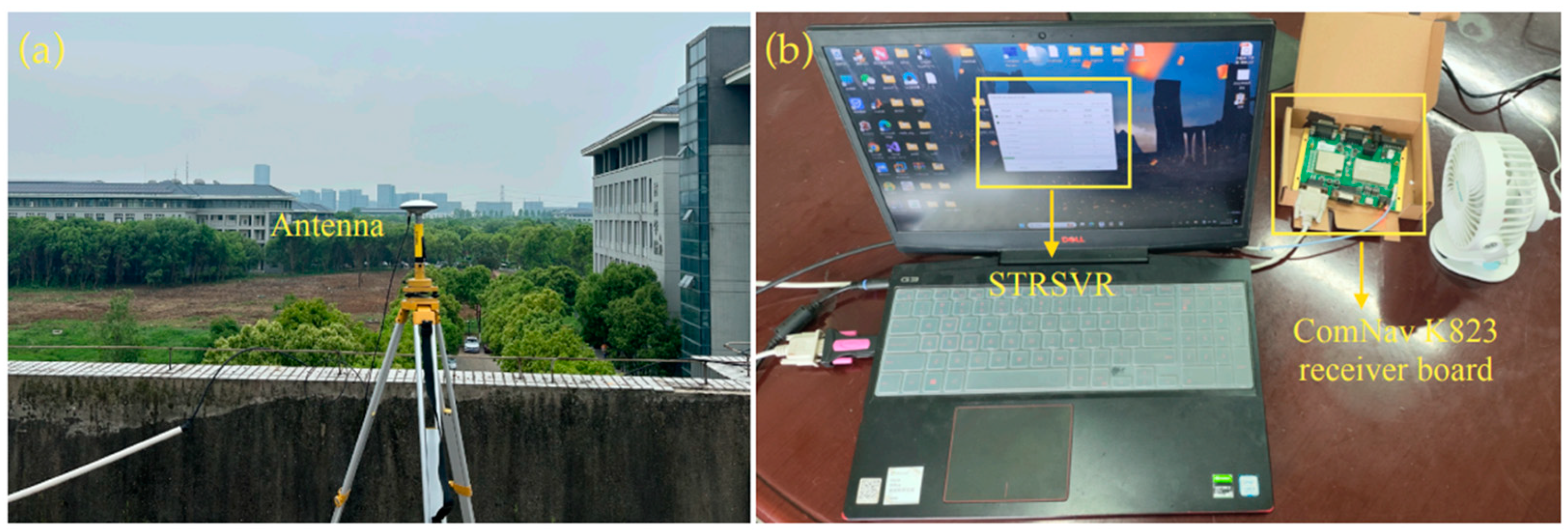

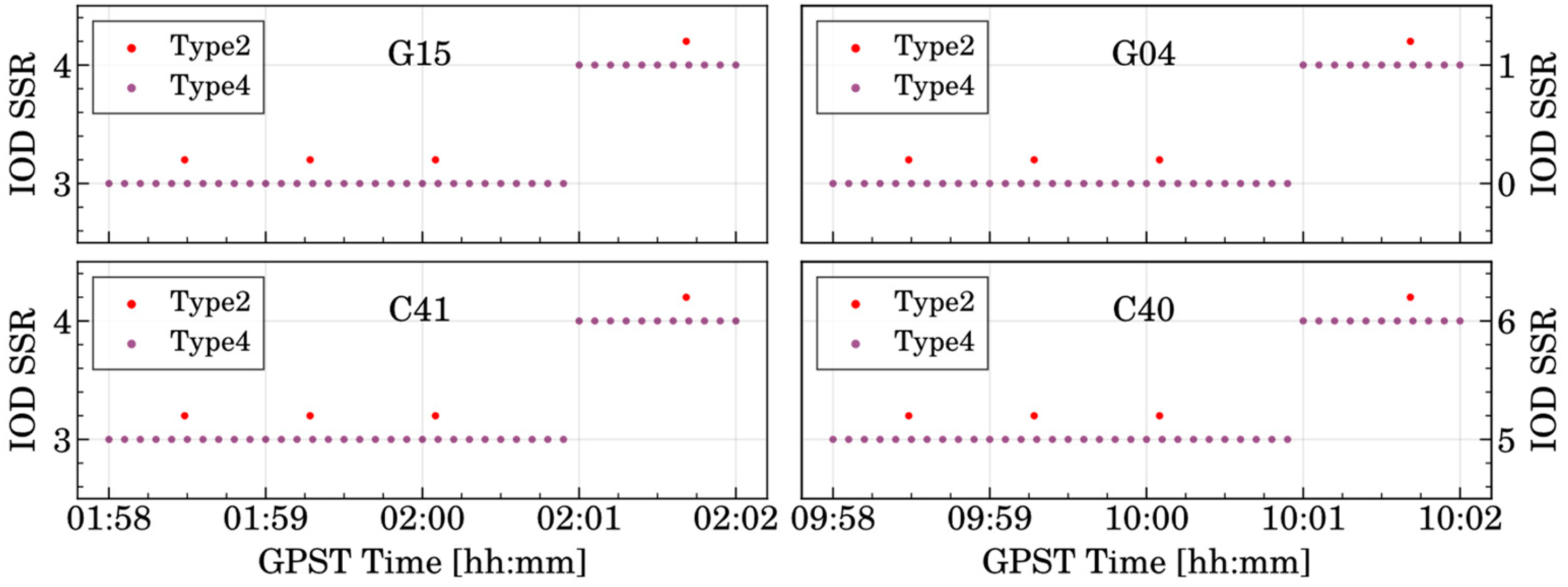


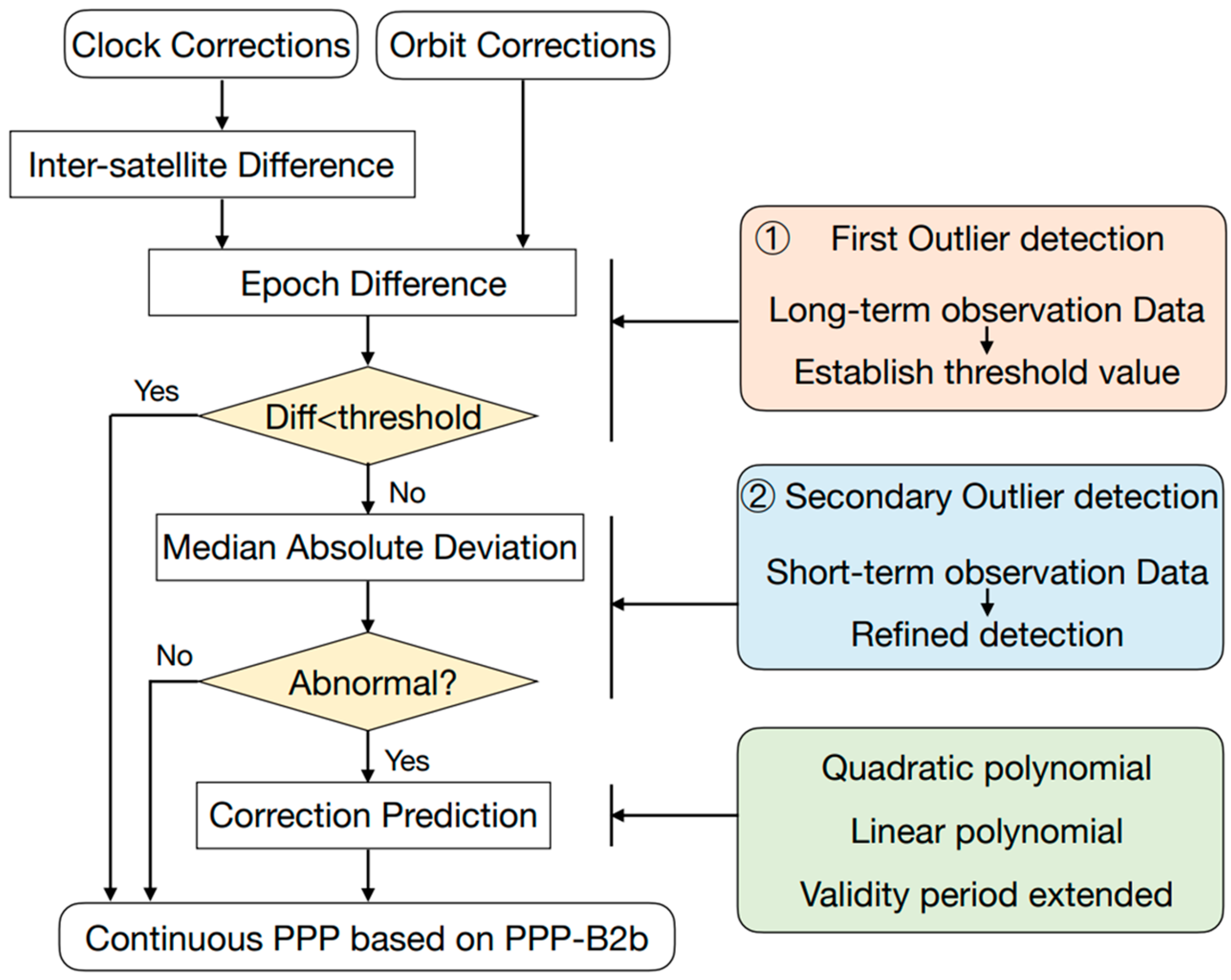
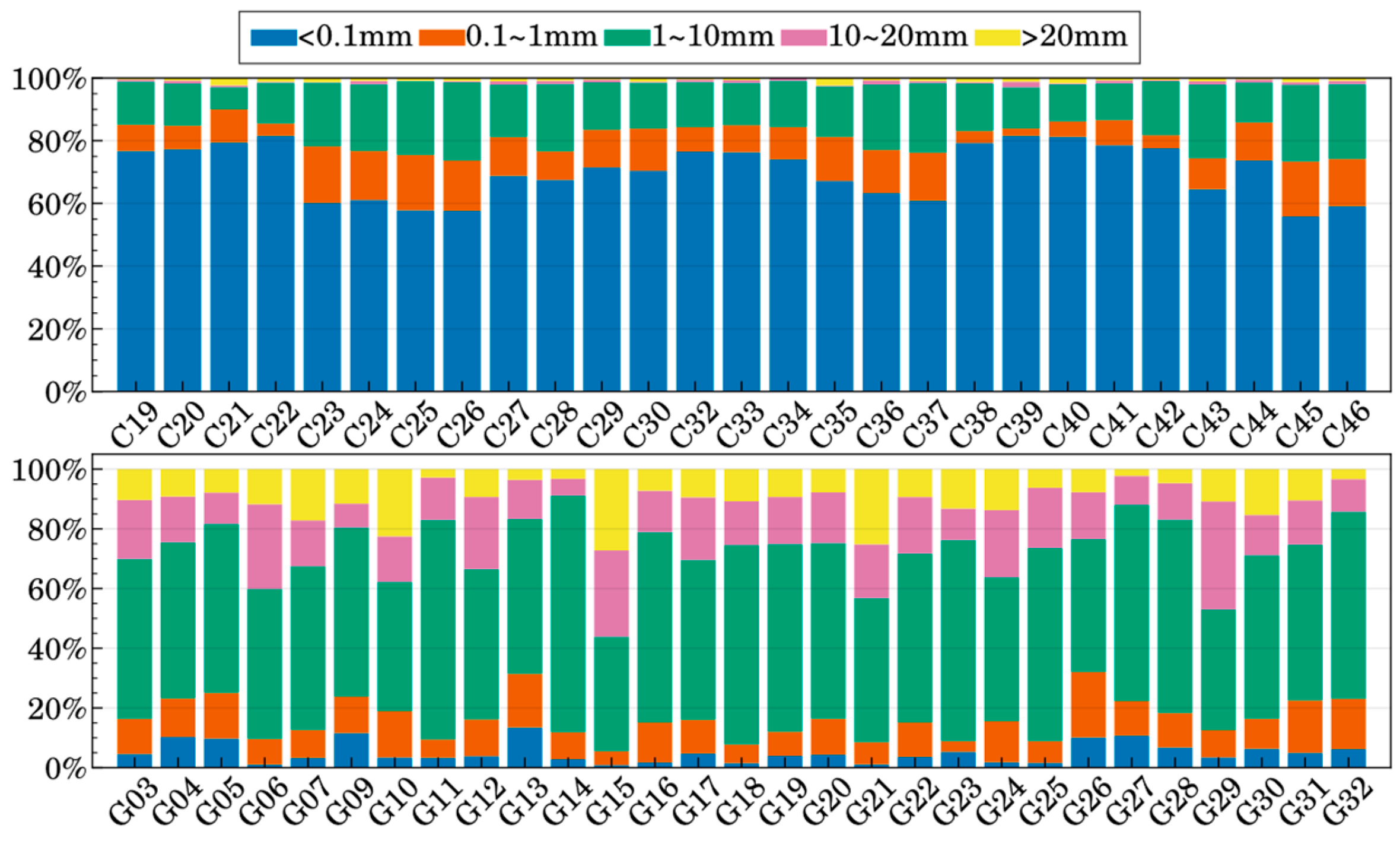
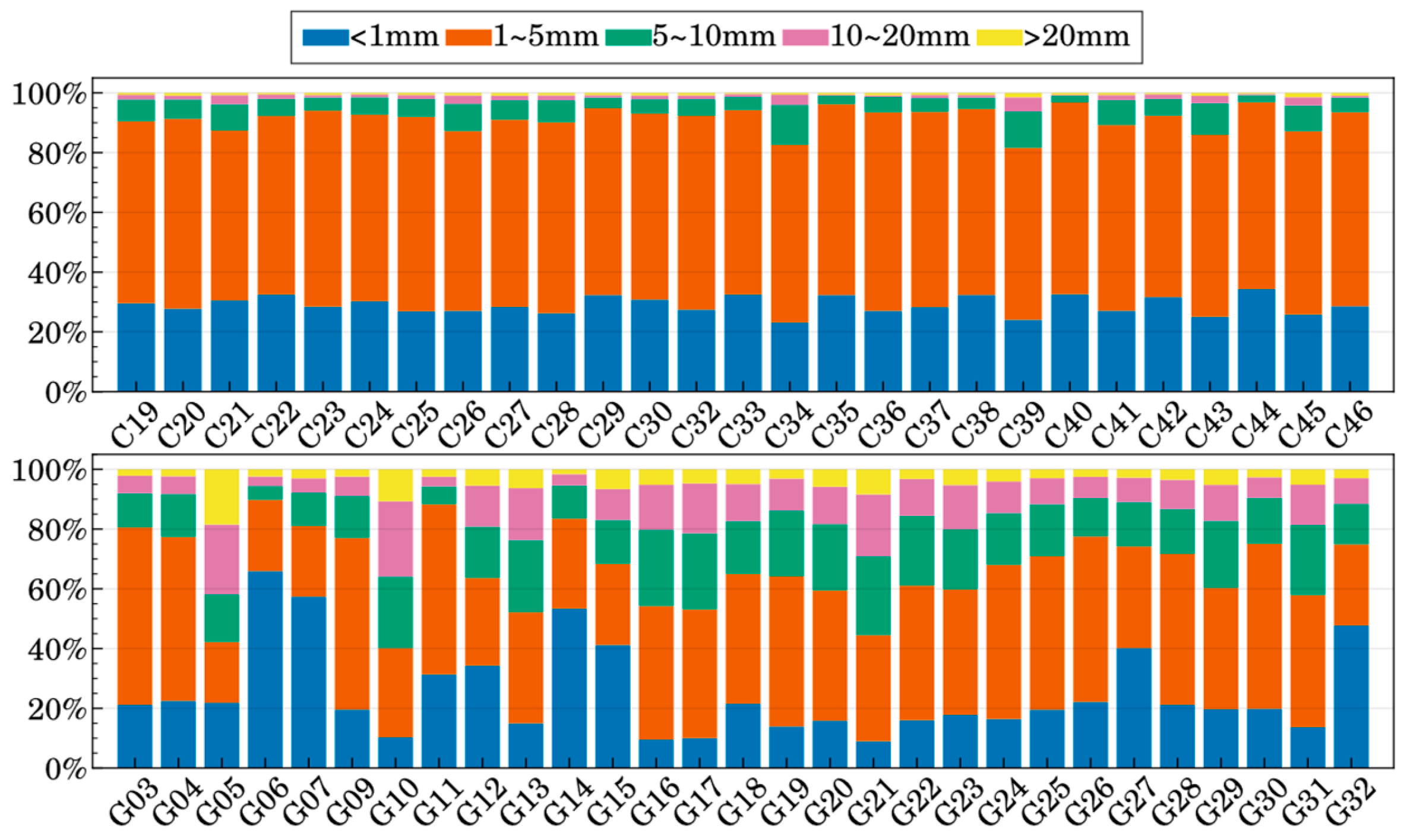
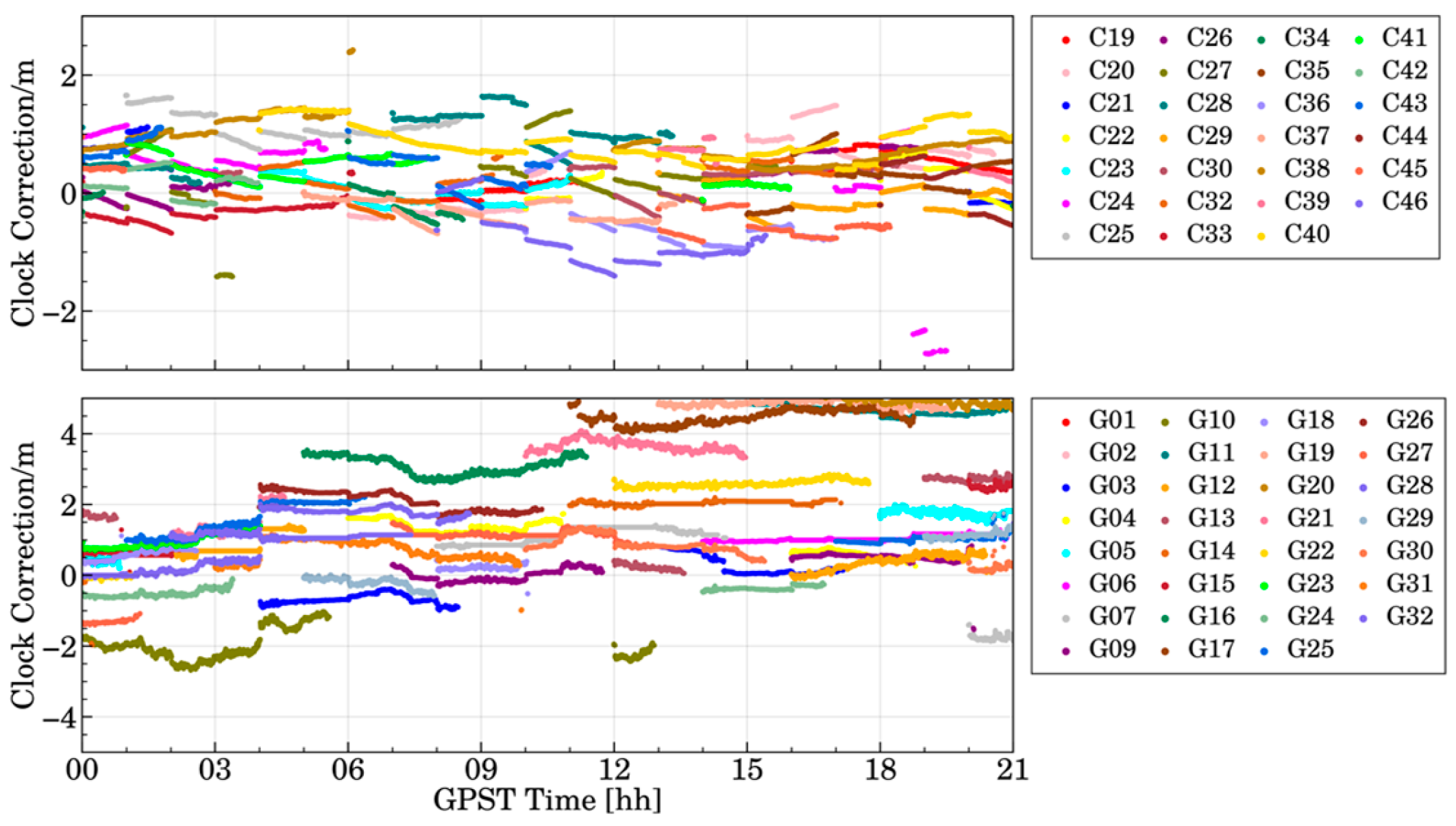
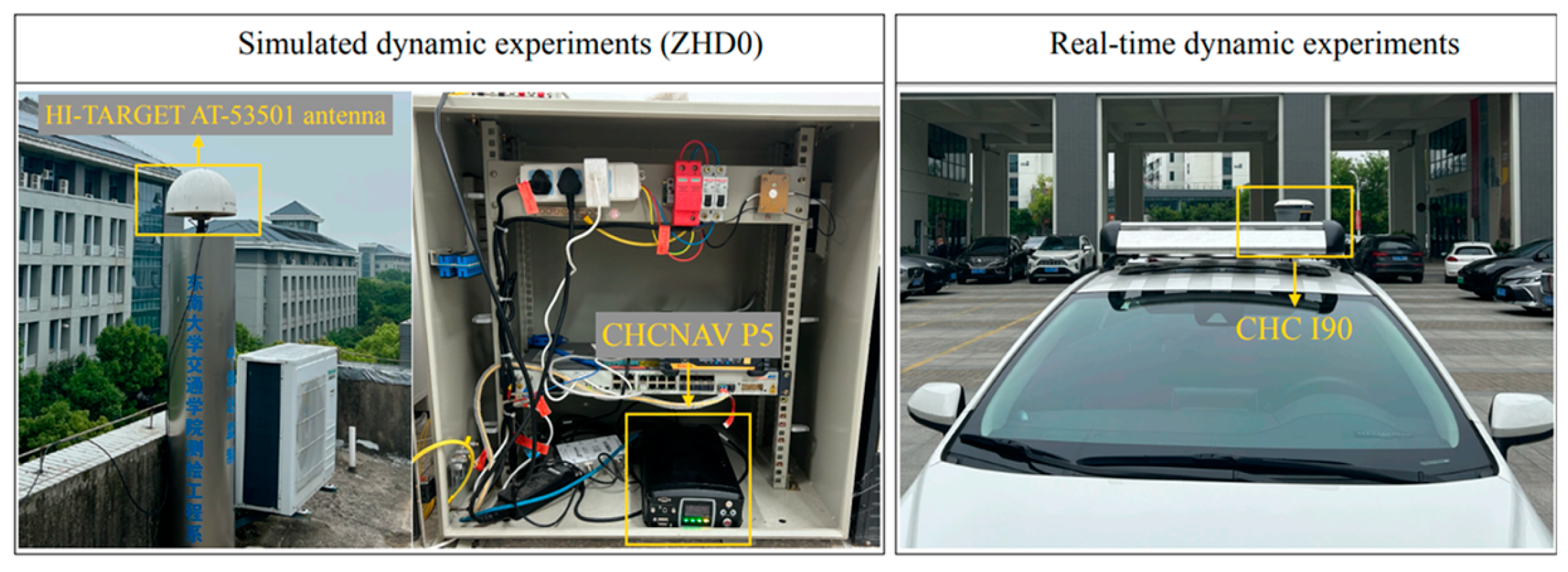
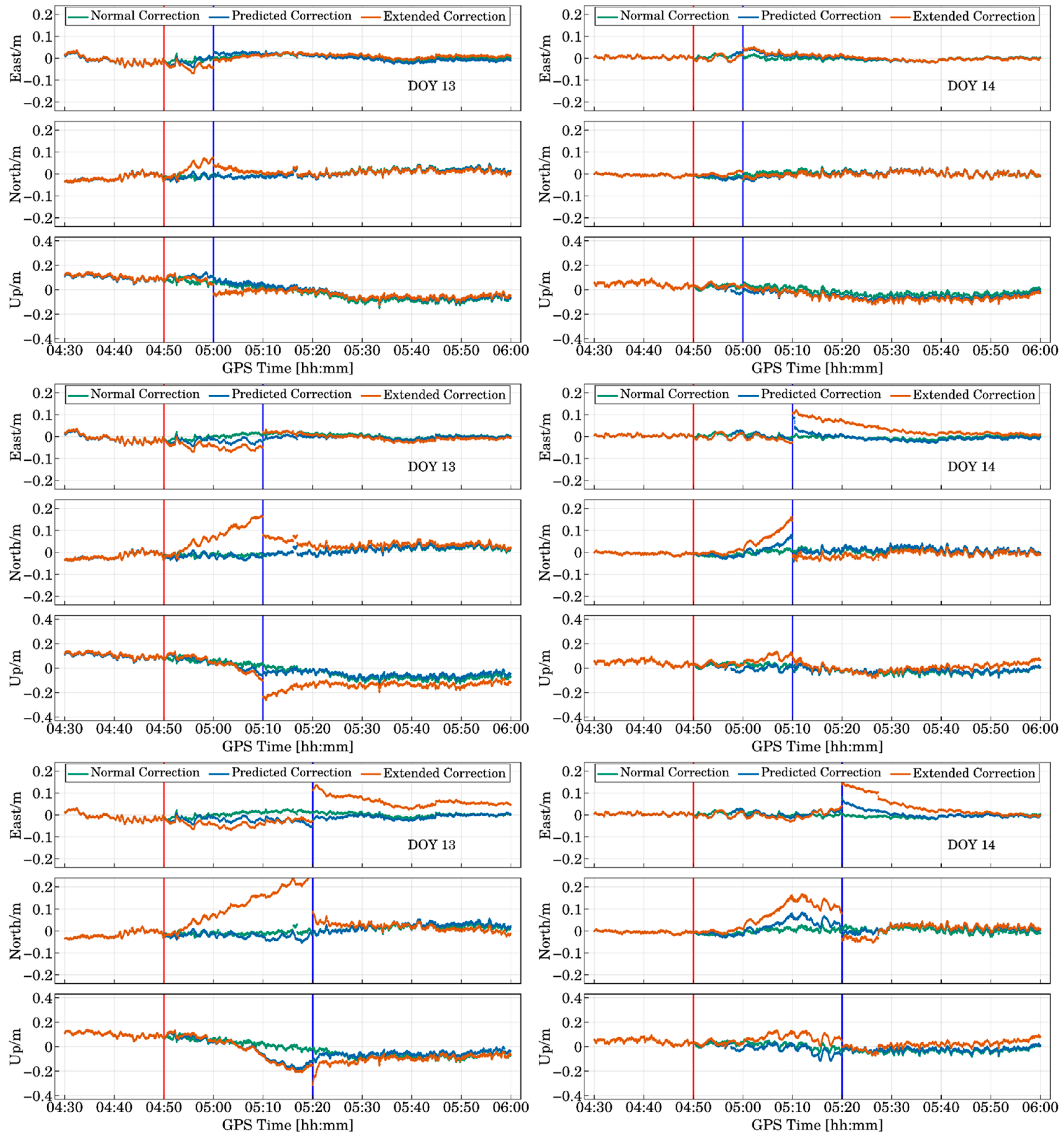

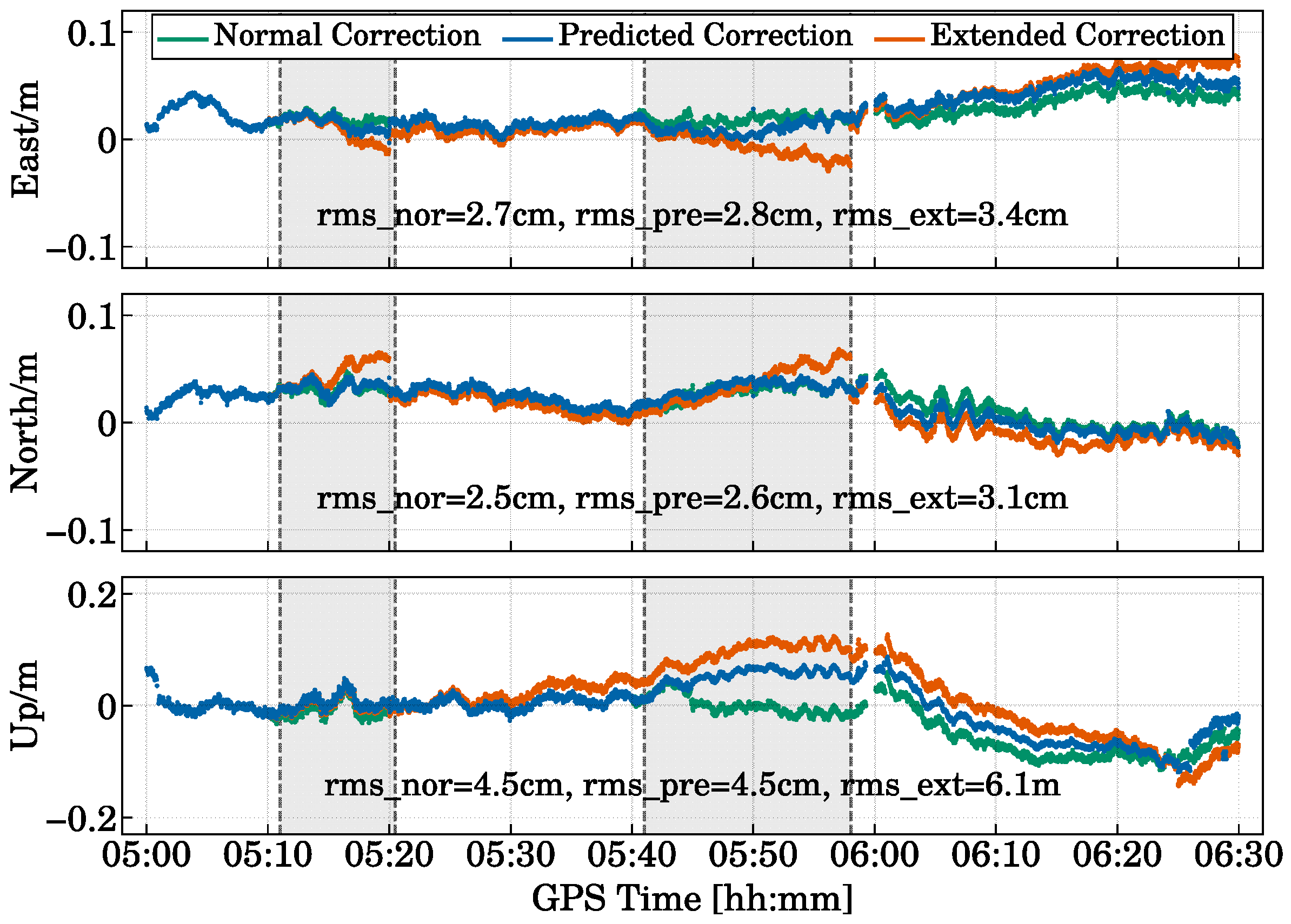
| Message Type | Information Content | Update Interval(s) | Nominal Validity | IOD |
|---|---|---|---|---|
| 1 | Satellite mask | 48 | —— | IOD SSR, IODP |
| 2 | Orbit correction | 48 | 96 | IOD SSR, IODN, IOD Corr |
| 3 | DCB | 48 | 86,400 | IOD SSR, |
| 4 | Clock correction | 6 | 12 | IOD SSR, IODP, IOD Corr |
| Item | Processing Strategies |
|---|---|
| Observations | Undifferenced code and phase measurements |
| GNSS signals | GPS (L1, L2), BDS-3 (B1I, B3I) |
| Satellite orbit/clock | ① Normal PPP-B2b orbit and clock corrections |
| ② Predicted PPP-B2b orbit and clock corrections | |
| ③ Extended PPP-B2b orbit and clock corrections | |
| Cutoff elevation | 7° |
| Weighting strategy | Elevation angle dependent: and for raw phase and code, respectively |
| Sampling rate | 1 Hz |
| Ambiguities | float |
| Atmospheric delays | Estimate the same zenith tropospheric delays in the antenna array using the Saas + GPT2 model [38] |
| Ionospheric delays | Estimate one ionospheric delay for each satellite in the antenna array |
| DOY (2024) | Sessions (GPST) | |||
|---|---|---|---|---|
| PPP Solution | Interruption | |||
| 13 | 4:00~6:00 | 10:00~12:00 | 4:50~5:50 | 10:30~11:30 |
| 14 | 4:00~6:00 | 13:00~15:00 | 4:50~5:50 | 13:30~14:30 |
| 15 | 2:00~4:00 | 14:00~16:00 | 2:50~3:50 | 14:50~15:50 |
| 16 | 3:30~5:30 | 14:00~16:00 | 3:00~4:00 | 14:50~15:50 |
| Interruption Times | Extended Corrections (m) | Predicted Corrections (m) | Improvements | ||||||
|---|---|---|---|---|---|---|---|---|---|
| E | N | U | E | N | U | E | N | U | |
| 0 min | 0.016 | 0.026 | 0.053 | - | - | - | - | - | - |
| 10 min | 0.030 | 0.038 | 0.135 | 0.024 | 0.026 | 0.121 | 20.0% ↑ | 31.6% ↑ | 10.4% ↑ |
| 20 min | 0.048 | 0.112 | 0.118 | 0.032 | 0.044 | 0.110 | 33.3% ↑ | 60.7% ↑ | 6.8% ↑ |
| 30 min | 0.059 | 0.189 | 0.222 | 0.034 | 0.064 | 0.178 | 42.4% ↑ | 66.1% ↑ | 19.8% ↑ |
| 40 min | 0.088 | 0.226 | 0.309 | 0.056 | 0.090 | 0.217 | 36.4% ↑ | 60.2% ↑ | 29.8% ↑ |
| 50 min | 0.146 | 0.254 | 0.319 | 0.076 | 0.124 | 0.216 | 48.0% ↑ | 51.2% ↑ | 32.3% ↑ |
| 60 min | 0.192 | 0.245 | 0.280 | 0.067 | 0.124 | 0.230 | 65.1% ↑ | 49.4% ↑ | 17.9% ↑ |
| Sessions (GPST) | Extended Corrections (m) | Predicted Corrections (m) | Improvements | ||||
|---|---|---|---|---|---|---|---|
| Horizontal | Vertical | Horizontal | Vertical | Horizontal | Vertical | ||
| 5:11~5:19 | RMS | 0.048 | 0.014 | 0.037 | 0.014 | 22.9% ↑ | 0.0% |
| MAX | 0.070 | 0.046 | 0.053 | 0.046 | 24.3% ↑ | 0.0% | |
| 5:41~5:56 | RMS | 0.037 | 0.095 | 0.034 | 0.054 | 10.8% ↑ | 43.2% ↑ |
| MAX | 0.064 | 0.123 | 0.052 | 0.074 | 18.8% ↑ | 39.8% ↑ | |
Disclaimer/Publisher’s Note: The statements, opinions and data contained in all publications are solely those of the individual author(s) and contributor(s) and not of MDPI and/or the editor(s). MDPI and/or the editor(s) disclaim responsibility for any injury to people or property resulting from any ideas, methods, instructions or products referred to in the content. |
© 2024 by the authors. Licensee MDPI, Basel, Switzerland. This article is an open access article distributed under the terms and conditions of the Creative Commons Attribution (CC BY) license (https://creativecommons.org/licenses/by/4.0/).
Share and Cite
Xu, Z.; Shang, R.; Gao, C.; Gao, W.; Liu, Q.; Long, F.; Xu, D. Temporal Characteristics Based Outlier Detection and Prediction Methods for PPP-B2b Orbit and Clock Corrections. Remote Sens. 2024, 16, 2337. https://doi.org/10.3390/rs16132337
Xu Z, Shang R, Gao C, Gao W, Liu Q, Long F, Xu D. Temporal Characteristics Based Outlier Detection and Prediction Methods for PPP-B2b Orbit and Clock Corrections. Remote Sensing. 2024; 16(13):2337. https://doi.org/10.3390/rs16132337
Chicago/Turabian StyleXu, Zhenhao, Rui Shang, Chengfa Gao, Wang Gao, Qi Liu, Fengyang Long, and Dawei Xu. 2024. "Temporal Characteristics Based Outlier Detection and Prediction Methods for PPP-B2b Orbit and Clock Corrections" Remote Sensing 16, no. 13: 2337. https://doi.org/10.3390/rs16132337
APA StyleXu, Z., Shang, R., Gao, C., Gao, W., Liu, Q., Long, F., & Xu, D. (2024). Temporal Characteristics Based Outlier Detection and Prediction Methods for PPP-B2b Orbit and Clock Corrections. Remote Sensing, 16(13), 2337. https://doi.org/10.3390/rs16132337





